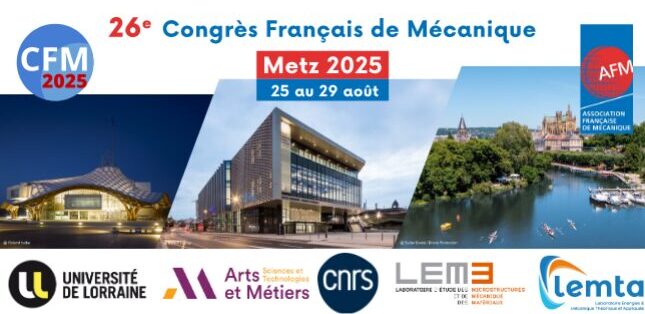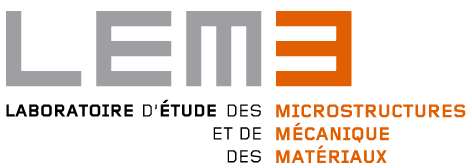- Campus du Saulcy, Université de Lorraine, Metz (provisional)
As part of the French Congress of Mechanics 2025

IInterfaces such as grain boundaries in polycrystalline as well as heterointerfaces in multiphase materials are ubiquitous in mechanics of materials with wide-ranging properties and applications. Therefore, understanding the role and the benefit of interfaces is key in optimization of metals, alloys, ceramics and composites for a wide range of applications including electrochemical energy conversion and storage, optical, magnetic, themomechanical, environmental applications.
Regarding the current challenges in the characterization, modelling and understanding the role of interfaces on the mechanical response of engineering materials, we have identified four areas of interest for our colloqium:
- Experimental methods and modeling approaches to characterize interfacial mechanisms,
- Grain boundary mechanics,
- Interfaces in heterogenous materials,
- Interfacial multiphysical couplings.
In addition, each of these four areas includes several specific topics (see below) that brings scientific discussions in the European and International communities of Solid Mechanics. A part of the symposium will be devoted to present new experimental techniques coupled with AI (artificial intelligence) methods that have been developed over the last years to refine the characterization of interfaces for different materials. Moreover, advanced multiscale modelling methods including discrete (atomistic simulations) and continuous-based modelling (micromechanical models) approaches will also have a special relevance in the symposium.
Another important issue that will be discussed in the meeting is the role played by material’s properties at or in the vicinity of interfaces (elasticity, plasticity, damage, fracture). Length scale effects as well as spatial/temporal and multiphysical couplings involved to describe the interfaces will be discussed. Algorithms and numerical methods for multiscale models (FE, FFT, Finite volumes, Finite differences, machine learning) dedicated to mechanics of interfaces will be of particular interest for this meeting.
As the interplay between the specific role played by interfaces, loading conditions, and microstructural features (e.g. grain/phase boundaries, solute concentration at interfaces), is currently an intense subject of discussion in the Solid Mechanics community, this colloqium aims at moving forward this debate. Moreover, we will also pay special attention to the multiphysic interactions which can be observed at interfaces. Topic 4 will be mostly devoted to the role of interfaces for energy storage (hydrogen, battery). Therefore we encourage the diffusion of research works in the context of sustainability.
This colloquium aims at gathering scientists from all horizons (mechanical sciences, material sciences, physics) in order to present their recent developments and results in this field. Potential participants are encouraged to present their latest results, including work in progress, with emphasis on cross-comparisons between theory, modelling and experiments. The main goal of the symposium is to probe the “state of the art” in this important field of solid/materials mechanics. We have elaborated a potential list of participants that covers, to a large extent, all the topics presented above. Each invited researcher will contribute to the topic that is closer to his/her current research interests.





